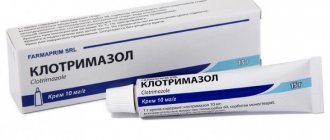Every woman at least once in her life has encountered gynecological problems and diseases that cause discomfort and sometimes put her in an awkward position.
But not many people know that these problems can be solved with the help of a drug such as Miramistin, which can be easily purchased at any pharmacy without a prescription form and for little money.
What is Miramistin needed for?
Miramistin is an excellent antiseptic substance that has a lethal effect on both gram-positive and gram-negative bacteria.
It is also active against almost all pathogens of sexually transmitted diseases, such as trichomoniasis, chlamydia, gonorrhea, trypanosomiasis and others.
This drug is also characterized by an antifungal effect in diseases such as dermatophytoses, thrush and others.
In addition, Miramistin is capable of activating a nonspecific immune response of the body, which significantly accelerates the healing of wounds, burn surfaces and other damage.
The drug enhances the effect of most antibiotics and also reduces the resistance of microorganisms to the latter.
It has a hyperosmolar effect, thus attracting pathological types of exudate and accelerating the formation of dry scabby tissue.
It does not have the ability to be absorbed through the skin and damaged areas into the blood, which makes it relatively harmless for pregnant women, as well as children of all age categories.
A separate and important property of miramistin is its destructive effect on the so-called “hospital” microorganisms, which are distinguished by their particularly high virulence (ability to cause disease), as well as fairly strong resistance to many antibacterial agents.
Thrush: causes and treatment
Thrush is a disease caused by opportunistic microorganisms of the genus Candida, which are yeast fungi that live in the body of every person.
All of them are part of the normal microflora, living in the mouth, vagina and rectum. This is what Candida fungus looks like
Thrush (candidiasis/candidomycosis) is characterized by:
- burning;
- itching;
- peeling;
- whitish coating;
- pain;
- specific acidic odor;
- redness of the integument;
- swelling.
Sometimes thrush is asymptomatic. Most often, the pathology manifests itself on the genitals in adults and in the oral cavity in children.
This is how candidal stomatitis begins
This is an infectious disease that can be transmitted sexually and domestically, as well as from mother to newborn child. At the same time, there is a possibility of spontaneous development of the disease due to weakened immunity due to long-term use of antibiotic drugs, psycho-emotional stress, allergies, and hormonal disorders.
The rapid growth of colonies of Candida fungi leads to the destruction of mucous membranes and the penetration of other pathogenic bacteria into the human body. With timely treatment, the risk of complications and secondary infection is minimal.
Treatment is carried out using local and general drugs. Only an integrated approach will get rid of this problem.
Forms of release of the drug
Miramistin is produced in the following types:
- Liquid for external use in a working dilution of 0.01% - produced in polyethylene bottles, volume 50 ml with a nozzle and 200 ml with an aerosol sprayer.
- 0.5% ointment - produced in tubes of 15g and 30g, as well as in plastic jars of 50g, 100g and 1000g.
- Liquid for disinfection of the mouth and throat - produced in bottles with a volume of 150 ml.
- Drops for the treatment of otolaryngological pathologies. (Okomistin and others).
pharmachologic effect
Miramistin is a broad-spectrum antiseptic. Interacts with the bacterial cell membrane, destroying it. Systematic invasion of the drug kills the pathogenic microorganism. The peculiarity and safety of the product is as follows - it is absolutely powerless in relation to the cells of the human body. Their unique structure differs sharply from the structure of viruses, fungi and infections.
Destroys gram-positive and gram-negative cells:
- streptococci and staphylococci;
- gonococci;
- spirochetes;
- salmonella;
- Escherichia;
- shigella;
- chlamydia;
- Pseudomonas aeruginosa.
Herpes, candidiasis, and influenza are also sensitive to the composition of the drug.
Miramistin fights chlamydia and other bacteria
Indications for use of Miramistin
Miramistin is used in many areas of medicine:
- In surgery and traumatology: for disinfection of infected people, skin lesions in the presence of purulent exudate, as well as for secondary treatment of wounds at the granulation stage;
- In otolaryngology: for the comprehensive treatment of sinusitis, sinusitis, sinusitis, various forms of tonsillitis, as well as uncomplicated otitis. The drug is approved for use by children by inhalation during acute respiratory diseases. For children under 12 years of age, the drug is mixed with 0.9% saline solution in a ratio of 1:2;
- Therapeutic treatment of burn surfaces of II and III degrees , as well as for the preparation of fresh burns for skin grafting. Quite effective in the treatment of burns caused by sunlight;
- In dental practice: for the healing of stomatitis, gingivitis, periodontitis, as well as to prevent the occurrence of infectious processes after surgical interventions on the mucous surfaces of the mouth. In addition to all of the above, this medicine is used to clean and disinfect dentures;
- In ophthalmology: use eye drops that contain 0.01% miramistin. They are effective in most viral, bacterial, and fungal keratitis, conjunctivitis, blepharitis, blepharoconjunctivitis. The use of miramistin is also permitted for purulent-inflammatory folliculitis (popularly called barley) in children over 3 years of age;
- In obstetric and gynecological practice: for the treatment of vulvovaginitis, cervical erosions, disinfection of postpartum injuries, including infected ones, as well as the prevention of infections caused by the birth process;
- In urology: for the comprehensive treatment of various forms of cystitis, inflammatory processes of the urethra, as well as urethroprostatitis caused by chlamydia, trichomonas, gonococci and other bacteria susceptible to the influence of miramistin;
- In venereology: for the prevention and general treatment of diseases transmitted through sexual contact: trichomoniasis, genital herpes, syphilis, candidiasis, gonorrhea;
- In dermatology: for the prevention and general treatment of mycoses of the feet and large muscle folds, fungal pathologies of the skin and mucous surfaces, onychomycosis, keratomycosis, as well as strepto- and staphyloderma. It is advisable to understand that in this case, Miramistin should be used as one of the auxiliary drugs in a comprehensive treatment, and in no case independently, since, most likely, such a treatment course will not bring the expected result.
In what cases is Miramistin used in women?
Women often use Miramistin at home for such pathological conditions as:
- prevention of the occurrence of symptoms of sexually transmitted diseases after intimate contact (gonorrhea, syphilis, HIV, herpes, chlamydia, trichomoniasis);
- prevention and treatment of fungal pathologies (genital candidiasis);
- treatment of metritis and vulvovaginitis caused by microbes sensitive to miramistin.
Miramistin: composition of the drug for intimate hygiene and contraindications
To treat diseases of the genitourinary system, the drug Miramistin with an antiseptic effect is used.
The composition of the drug Miramistin includes an active component with biological activity - Miramistin, and sterile water as an excipient. Other components are not included. The medication is available in the form of a solution for local use.
The liquid is colorless and odorless and begins to foam when shaken. Let's consider what effect the drug has and when it is used?
Pharmacological action and pharmacokinetics
The drug is available in the form of a solution. Bottles of 50, 100, 150 and 200 ml are sold in cardboard packages. The drug belongs to the pharmaceutical category of antiseptics. Tablet form, suppositories and other forms of release do not exist.
For information, the solution has antimicrobial properties, including its effect on strains of pathogenic microorganisms that are resistant to the effects of strong antibacterial drugs.
The medication has a bactericidal effect against gram-positive and gram-negative microbes. Gives an antifungal effect, helps destroy yeast-like fungi and dermatophytes.
In accordance with the information presented on Wikipedia, the drug is characterized by an antiviral effect and helps destroy complex viruses - herpes, immunodeficiency. The drug actively eliminates pathogens that are transmitted through sexual contact.
The use of the medicine helps prevent the process of wound infection, accelerates the regeneration of damaged tissues, and stimulates the natural barrier functions of the body (locally only). When used locally, the drug is not absorbed into the circulatory system and skin.
Indications and side effects
The instructions for use of Miramistin state that the drug is used for the treatment and prevention of diseases of the genitourinary system in men and women. The medicine does not provoke irritation and helps to stop inflammatory processes of any etiology.
Indications for use:
- Pathologies of the genitourinary system;
- Inflammation of the urethral canal;
- Inflammation of the prostate gland;
- Balanitis, urethritis, urethroprostatitis;
- Candidiasis of the mucous membranes.
The solution has found wide use not only in urological, but also surgical, gynecological, ophthalmological (they use a product based on miramistin - Okomistin), pediatric, dental and ENT practice.
Worth knowing: Miramistin for children is recommended for exacerbation of pharyngitis and chronic tonsillitis. Up to three years of age it is used strictly for medical reasons, up to one year - exclusively under medical supervision.
What are the contraindications for use? Do not use the drug if you are hypersensitive to the active substance. In other cases, use is allowed, even in the presence of serious chronic diseases, during pregnancy, and breastfeeding.
Miramistin has extremely rare side effects. Some people note a slight burning sensation after use, but it goes away on its own within five minutes. A likely negative consequence may include an allergic reaction if the patient is intolerant to miramistin.
The solution is used as a prophylaxis against sexually transmitted diseases:
- Chlamydia, ureaplasmosis, mycoplasmosis.
- Gonorrhea, syphilis, fungal infections.
It is recommended to use Miramistin for intimate hygiene after unprotected sexual intercourse to prevent the development of sexually transmitted diseases. Overdose of the drug has not been registered.
Instructions for use of the drug
If the patient is prescribed Miramistin, then the instructions for use must be followed in accordance with all recommendations. Before using the solution, first remove the cap and attach the spray nozzle to it. This can be used for wetting compresses, for spraying on wound surfaces, etc.
Method of use of Miramistin for men (for the treatment of pathologies of the genitourinary system):
- Take a 20 cc syringe that is equipped with a rubber tip;
- Draw the solution into a syringe;
- Expose the head of the reproductive organ, carefully insert the tip into the urethral canal, press the syringe plunger;
- The medicine is injected slowly. The dosage is up to 3 ml, unless otherwise recommended by a medical specialist;
- Remove the tip, wait until the solution flows out of the urethra on its own;
- If necessary, repeat the manipulation several times;
- The duration of the treatment course is determined individually.
If the product is used to prevent sexually transmitted diseases, then inject 2-3 ml into the urethra. Additionally, you need to apply the solution to a cotton pad and treat the skin near the genitals.
In urology, an effective antiseptic has found wide use. This method, described above, involves washing the anterior urethra. This is enough to prevent sexually transmitted diseases. In turn, the posterior urethral canal is also washed with the help of the medicine, but only a doctor can do this.
The procedure is performed in a hospital setting. The doctor draws the solution into a syringe, which is equipped with a rubber nozzle. The man lies on his back, lifts his legs up and bends his limbs, supporting them with his hands. The doctor exposes the head of the reproductive organ and slowly injects the medication.
Important: Miramistin is not an antibiotic. But when combined with antibacterial and antifungal drugs, an increase in the effects of the latter is observed.
Miramistin for the intimate area is an effective remedy. For unprotected sexual intercourse, it is recommended to use it no later than two hours after it. Note that before use you need to empty your bladder - urine will wash away some of the bacteria from the urethral canal.
Application of Miramistin in gynecology
During the course of treatment of “female” problems, a 0.01% solution of Miramistin is often used, which does not require additional dilutions before use.
The source of first aid is for:
- Pathological processes of an inflammatory nature in the mucous layer of the vagina;
- Postpartum tissue damage, vaginal injuries and prevention of their infection;
- Inflammation in the mucous layer of the uterus with the formation of pus;
- Treatment of sexually transmitted diseases and their prevention;
- In the complex treatment of pelvic pathologies;
- Diseases of the vaginal cavity are caused by fungi sensitive to miramistin.
Methods of using Miramistin
Only a doctor can determine how to use the drug, depending on the nuances and severity of the disease, the individual susceptibility of the patient’s body, the presence of aggravating pathologies, as well as contraindications for use.
There are such ways to use the drug:
- Using vaginal tampons. To do this, you should form the correct gauze swab of the appropriate size, or take a ready-made one, moisten it with Miramistin solution and insert it into the vagina. This method of administering the drug is very useful and is used for endometritis, metritis, as well as in the comprehensive treatment of cervical erosion. The duration of treatment should not be less than seven days; only the attending physician can extend or shorten the course.
- Introduction of miramistin into the urogenital canal through a catheter. Such manipulations are carried out in the treatment of cystitis and urethritis of varying complexity. Relief occurs after the first procedure, but to completely eliminate the disease it is necessary to undergo them at least three times.
- Douching. It is necessary to inject the drug to the site of inflammation. The positive side of this manipulation is that it is quite easy to perform and you do not need any special equipment to douche. Most often, this method is used to cure or prevent the occurrence of sexually transmitted diseases after sexual contact, as well as for pathological conditions of the vagina, fungal etiology.
- Electrophoresis (carrying the drug deep into the tissue using a low voltage electric current). This method of therapy is used for the comprehensive treatment of pelvic pathologies (cystitis, salpingitis, adnexitis and others). To significantly improve your general condition, you need to do at least 10 sessions in stages.
- Using Miramistin in the form of an ointment. In gynecological practice, Miramistin ointment should be used extremely rarely, mainly for healing ruptures that occur during childbirth, surgical wound surfaces and damage to the skin layer.
Miramistin and women's diseases
Miramistin helps well with the following female pathologies:
- Inflammatory process of the vaginal mucosa;
- Inflammatory process of the mucous layer in the uterus;
- Pelvic pathologies: adnexitis, salpingitis, bartholinitis, “adhesive disease”;
- Fungal pathologies in the vagina (urogenital candidiasis);
- Treatment and prevention of sexually transmitted diseases.
Use of miramistin during pregnancy
This product has successfully passed special clinical trials and has not shown a single embryotoxic effect.
However, many doctors warn against its use during the first trimester of pregnancy.
Its use in some cases leads to increased skin sensitivity in the fetus.
This leads to the occurrence of dermatitis and allergies.
Despite the relative safety of the drug, its prescription should be strictly according to indications and only on the recommendation of the attending physician.
Use after childbirth
Instructions for use after childbirth:
- Treatment of postoperative suture (for caesarean section). For this purpose, it is preferable to use the drug in the form of a solution, since the ointment does not allow the skin to breathe, which means that the healing process will only be delayed. To process the sutures, you should prepare in advance everything necessary for a new dressing: a sterile gauze swab, hydrogen peroxide, scissors, and adhesive tape. Next, you need to get rid of the old bandage, disinfect the seams with hydrogen peroxide until the reaction stops completely, only after that should Miramistin be applied. Next, it is advisable to cover the seams with a sterile swab and secure with a bandage.
- Treatment after natural birth:
- Wounds of the perineum, for the sanitation of external female organs; in this case, it is preferable to prescribe Miramistin in the form of a spray or just a solution;
- Damage to the mucous surface of the vagina, as well as the cervix.
- In the therapeutic treatment of such problems, daily douching with Miramistin solution is most often prescribed for a week. In the most difficult cases, it is possible to extend therapy up to 1 month;
- Sometimes you can use tampons soaked in a miramistin solution.
- Complicated damage to the tissues of the genital organs with the formation of purulent exudate. In this variant of the disease, tampons soaked in a miramistin solution are used. Tampons should be changed at least six times a day. The duration of such treatment is determined by the gynecologist.
Miramistin for thrush in women and men
Thrush in women is characterized by severe itching of the genitals, swelling of the mucous membranes, an unpleasant sour odor and abundant curdled vaginal discharge, white or yellowish in color.
Unpleasant sensations occur during sexual intercourse; if left untreated, the mucous membrane of the labia becomes covered with small bleeding ulcers.
In case of unpleasant symptoms, you should consult a doctor to clarify the diagnosis and prescribe treatment.
Being a local antiseptic, Miramistin actively destroys pathogenic microflora for thrush, practically without being absorbed into the bloodstream and without causing any harm to the human body. It is used as a primary drug or in combination with other drugs.
As a rule, Miramistin against thrush is prescribed together with antibiotics; the product is used for irrigating the infected surface and douching.
The medicine bottle is equipped with a special nozzle that makes it easier to use.
To treat thrush with Miramistin, women need to carefully insert the nozzle into the vagina and inject about 10 ml of solution. The procedure is carried out lying down, the medicine is kept in the vagina for 7-10 minutes. Douching is done in the morning and evening, and one should not forget about hygiene procedures and changing underwear.
Even if significant relief occurs after the first procedure, douching continues for 6-7 days. The product does not harm the vaginal mucosa. Miramistin for thrush quickly and effectively fights the pathogen, but treatment should be a course of treatment.
Self-discontinuation of the drug can provoke the transition of the disease to a chronic form. In this case, it will be much more difficult to get rid of it.
When douching, the preparation is irrigated into the pubic area, inner thighs and outer labia. Only in this case can we talk about the complete destruction of the fungal infection.
During the treatment period, you must abstain from sexual intercourse; after completing the course, you should undergo tests to ensure complete recovery.
Burning in the vaginal area occurs for many reasons, so it is difficult to completely eliminate the possibility of this symptom.
There are several ways to prevent burning in the intimate area:
- wash yourself more often;
- wear cotton underwear;
- adjust your daily diet by eliminating fatty and spicy foods;
- periodically wash your genitals with antiseptics;
- in hot weather, apply talc to the perineal area;
- Visit your gynecologist at least once a year.
A burning sensation in the intimate area often indicates the course of a pathological process caused by infection of the genital organs. To stop this unpleasant phenomenon, it is necessary, with the help of a doctor, to select a drug that eliminates the causative factor.
Pharmacy products
Medications form the basis of therapy used for itching and burning in intimate places in women.
Such medications are selected taking into account:
- causative factor (disease, allergic reaction or other);
- woman's condition (pregnancy, menopause);
- concomitant symptoms, when treatment of several pathologies is required simultaneously.
Remedies against burning in the intimate area in women are available in the form of vaginal suppositories, creams, ointments and tablets.
Lactacid
Lactacid intimate cream contains a 1% solution of lactic acid, which creates a protective barrier on the vaginal mucosa. The drug is used to eliminate burning sensation in the labia area, pain and other unpleasant symptoms.
The product suppresses the activity of pathogenic microorganisms, which allows you to get rid of itching. Lactacid is recommended for both the prevention and treatment of diseases of the genital area.
Clotrimazole
Clotrimazole is indicated in cases where the appearance of severe itching and burning in the intimate area in women is caused by the development of a fungal infection of any etiology. If the genital organs are affected, the drug is used in the form of vaginal suppositories.
Vagisil
Vagisil eliminates the manifestations of thrush on the labia, burning sensation and restores the vaginal microflora. This drug eliminates the unpleasant odor characteristic of candidiasis.
Vagilak
If itching and burning occurs in the labia, Vagilac is recommended, which restores the vaginal microflora. The product can be used as first aid for the initial signs of infection of the female organs.
Pimafucin
Pimafucin is prescribed for candidiasis. The drug relieves symptoms of itching and burning in the genitals and suppresses the activity of fungi. Like many other ointments for the intimate area, the product can be used to prevent candidiasis.
Contraindications for use
Use is extremely undesirable for patients with increased susceptibility to the active ingredient, as well as additional substances of this drug.
The prescription of Miramistin for children under 3 years of age should be strictly discussed with the attending pediatrician. In this case, the working solution should be mixed with water in a ratio of 1:1 or 1:2. In this case, constant monitoring of the child’s health is necessary.
The drug should be used with caution in patients with chronic skin diseases.
Instructions for use of Miramistin
Miramistin solution is used as follows:
- To treat trauma pathologies, burns and wounds, surfaces are treated with a solution of the product, aseptic dressings are applied, which are irrigated with a solution of miramistin. The frequency of such manipulations should be at least 3-4 times a day for the entire time it takes to recover. Sometimes, simply wetting the wound surface several times throughout the day is enough.
- In gynecology: for irrigation of the mucous surface of the vagina and cervix before the onset of the birth process, for baths after gynecological examinations, as well as for the healing of ruptures and postpartum surgical traumatic conditions. Treatments are carried out at least 2 times a day for a week; in some cases, treatment may last a little longer.
- It is also used during cesarean section to treat the surgical wound on the uterus and wash its inner surface.
- To prevent the occurrence of genital infectious pathologies. It is advisable to use Miramistin solution no later than 2 hours after unprotected sexual intercourse. Before treatment with the drug, it is necessary to carry out a set of hygienic procedures in relation to external female organs. Next, 1-2 ml of the contents of the bottle are used for external washing of the vagina, then about 10 ml of the product is injected inside for 3 minutes. You can also wash the skin of the inner thighs and buttocks with the solution. After using the medicine, it is advisable not to go to the toilet “little by little” for 1.5-2 hours.
- In urology: prescribed as part of complex treatment for various forms and courses of cystitis. To do this, miramistin, diluted with saline in a 1:1 ratio, is injected into the bladder cavity. Such procedures should be repeated at least 5 times.
- Vaginal tampons are also used, which are irrigated with miramistin solution. Tampons are inserted deep into the vagina and left there indefinitely. It is advisable to change such tampons several times throughout the day for 5-7 days.
- In otolaryngology: to cure sinusitis, it is recommended to rinse the paranasal sinuses with the required amount of solution until the exudate is completely washed away; for inflammation of the outer ear, turunda is soaked in the medicine and placed in each ear for half an hour three times a day. The duration of the course of treatment should be at least one week. For otitis media, miramistin in the form of drops is instilled into each ear, 2-3 drops 2 times a day for at least 10 days.
- Recommended for disinfection of the oral cavity after surgical interventions , as well as for the treatment of various forms of laryngitis, pharyngitis, and tonsillitis. To do this, it is recommended to rinse your mouth repeatedly with Miramistin solution every day. The amount of the drug should be at least 15 ml per rinse.
- In ophthalmology: for the treatment of conjunctivitis, blepharitis, keratitis and other diseases, eye drops are instilled 3-4 times a day for 7 days. For purulent folliculitis, apply a bandage to the affected eye. To do this, you need to moisten a gauze swab in the miramistin solution, squeeze it slightly and apply it to the closed eye for 45-60 minutes. For a speedy recovery, repeat this procedure at least 5 times. To use the drug in the form of a spray, you should first remove the cap, then remove the spray nozzle from the box and attach it to the spout at the top of the bottle. After this, you need to activate the sprayer by double pressing it.
- For the treatment of acute tonsillitis with a spray: for children over 3 years of age, one spray of spray per procedure is sufficient; children over 6 years old need 2-3 sprays of the drug; adolescents over 12 years of age and adults – at least 4 sprays. Also in such cases, children use a rinsing solution: children aged 3-6 years need 4-5 ml of miramistin, which is mixed with water in a 1:1 ratio; for children aged 6-12 years – 8 ml of a regular solution of the drug will be enough; children over 12 years old – 10-12 ml per rinse.
- inhalations have a good effect , which are prescribed to children for residual cough, chronic bronchitis, and in the complex treatment of pneumonia. To do this, you need 4-5 ml of 0.01% Miramistin solution per procedure. For children under 12 years of age, the drug is mixed with an isotonic NaCl solution in a ratio of 1:1 or 1:2.
Miramistin for intimate hygiene - how to use
To treat diseases of the genitourinary system, the drug Miramistin with an antiseptic effect is used.
The composition of the drug Miramistin includes an active component with biological activity - Miramistin, and sterile water as an excipient. Other components are not included. The medication is available in the form of a solution for local use.
The liquid is colorless and odorless and begins to foam when shaken. Let's consider what effect the drug has and when it is used?
Instillation
The use of Miramistin for instillation of the bladder is best left to professionals. Lack of practical skills is fraught with additional damage and increased inflammation.
In women, instillation is carried out in a hospital setting on a gynecological chair. The bladder is emptied using a catheter. Then, through a tube inserted into the urethra with a syringe of the required volume, the solution is slowly poured directly into the cavity of the bladder.
To reduce discomfort, the liquid is preheated. The catheter is removed and the urethra is briefly clamped. The doctor recommends keeping the solution for at least 2 hours, the longer the better.
A lasting therapeutic effect can be achieved after 7–10 procedures.
Release forms
Miramistin is available in different forms. Any of them can be used in the treatment of cystitis.
Colorless transparent liquid, packaged in bottles of 50, 100, 150, 200, 500 milliliters.
A solution with a concentration of the active component of 0.1 g is completely ready for consumption. Manufacturers were concerned about ease of use and equipped the packaging with a special urological applicator, a pump with a spray, and a gynecological nozzle.
The ointment is distributed in tubes of 15, 30 g. Each unit of mass contains 0.5% of the active substance.
Suppositories are produced under the patented name Tamistol. Contains 0.015 g of miramistin. The package contains 1 - 2 blisters of 5 suppositories.
Similar medications
The following drugs have approximately the same therapeutic effect as Miramistin:
- Septomirin;
- Okomistin;
- Miramistin-Darnitsa.
Many patients have already experienced the effect of the antiseptic on themselves in the treatment of various diseases, as a result, reviews about it are only positive. Therefore, it is recommended to have Miramistin in every home medicine cabinet.
Miramistin appeared in the 70s of the last century in the Soviet Union. The drug was developed for the Space Biotechnology program to disinfect spacecraft. Colonies of fungi and bacteria settled on board; no one could cope with them. The drug Miramistin helped. Today Miramistin is very popular.
Miramistin for children under one year of age and older is used until symptoms are completely eliminated and prevention is performed. It has a unique spectrum of action and antiseptic properties (blocks the development of microbes). Miramistin is an active ingredient in the drug that indiscriminately destroys pathogenic microbes. Kills harmful microorganisms; they cannot adapt to it.











